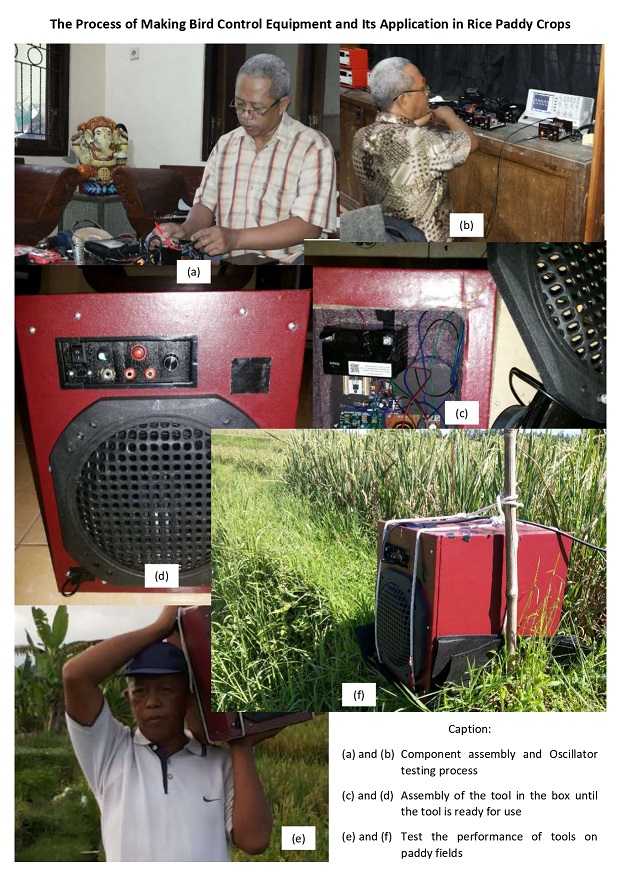Design of Electronic Bird Control Equipment and Its Application in Rice Paddy Crops
14/06/2020 Views : 329
I GDE ANTHA KASMAWAN
Design of Electronic Bird Control Equipment and Its Application in Rice Paddy Crops
By:
I Gde Antha Kasmawan
Department of Physics, Faculty of Mathematics and Natural Sciences, Udayana University
The electronic bird control equipment is designed with the main 3 kHz oscillator circuit. The equipment is made with 4 duration shots of sound. Electric power is provided by a 12-volt dry battery (battery accumulator) and speakers from the full range of 8-inch speakers and is packaged so that they can be operated portable. For safety, the whole electronics devices are packaged in boxes that have leak-proof coatings. The maximum sound intensity that the equipment can produce is around 123.7 dB.
The application of bird control equipment in the field needs to consider sound absorption in the air. Above the rice field bund, the sound intensity decreases dramatically to around 80 dB (5 m) and 68 dB (10 m) from the original intensity of 123.7 dB (0 m). Meanwhile, on top of rice panicles (in the surface area of rice cultivation), the sound intensity decreased to around 95 dB (10 m) and 85.3 dB (15 m). Sound attenuation tends to be higher for frequencies above 2 kHz especially in dense environments including paddy fields or grassland habitats. However, at a distance of 10 m, the sound is still quite disturbing hearing birds.
Besides considering sound attenuation in the air, it is also necessary to observe bird behavior in the field. During field observations, all types of munia birds exhibit behavior with certain characteristics when they are threatened. One or several birds will emit a sound code (danger alarm) and fly suddenly which is immediately followed by other birds. As long as it is threatened, every bird always strives to remain in its group.
There are two results of the application of the equipment in the field, namely the minimum number of shots needed to dispel spot munia birds and the response time of the birds to impulsive sound shots is calculated from the time the first sound shot was given. Spot munia birds can be driven away entirely at a maximum distance of 10 m with 2 shots and a response time of about 4 seconds. The number of birds can be driven according to the number of birds in the field and varies from a range of 5-78 birds.
During use, the equipment is positioned stationary against the earth so that the frequency shift factor due to the presence of the Doppler effect can only occur when there is a flight of birds and the speed of sound in the air. The direction of flight of birds is always away from the source of the sound so that the frequency of sounds heard by birds tends to be slightly lower than 3 kHz. However, the decrease in sound frequency only decreases with a correction factor of less than 1%. Thus, frequency shifts due to the Doppler effect can be ignored.
The application of an electronic bird control equipment to birds of spot munia can cause the bird to fly away. This is in accordance with the terms of the use of acoustic techniques in bird PHT that the technique can be effective if the sounds used are heard, detected, and relevant. The application of spot munia bird control equipment in the field is very effective at an interval of 10 m. The application of the tool is expected to be developed further to support the smart farming program in helping farmers maintain their rice plants so they can avoid losses due to bird pest attacks.
This research is inseparable from the guidance of professors at Udayana University, namely Prof. Dr. Ir. I Wayan Supartha, M.S., Prof. Dr. Ir. I Nyoman Wijaya, M.S., and Prof. Ir. Ida Ayu Dwi Giriantari, M.Eng.Sc., Ph.D. For that reason, the author is very grateful for his guidance as long as the author took his doctoral study at the Faculty of Agriculture, Udayana University.

